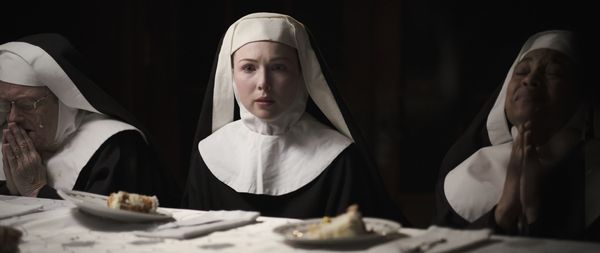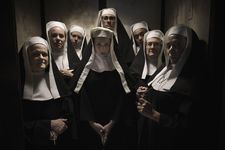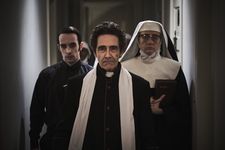 |
| Agnes Photo: Stephan Sutor |
Mickey Reece is a filmmaker like no other. One of the few independent directors to consistently deliver wholly original yet polished works, he has an approach to character and storytelling that really makes him stand out from the crowd. His latest work, Agnes, begins with two priests travelling to a convent to attend to a young nun who is believed to be possessed, but ends up going in a completely different direction from most films of that ilk. It’s screening as part of this year’s Fantasia International Film Festival and I caught up with Mickey halfway through to talk about it.
The last time we spoke, I reminded him, he told me that he was in post-production on Agnes and that it was made with the biggest budget he’d ever worked with. He points out that this doesn’t mean it was a big budget, but nonetheless, I ask him if it changed the way he worked.
“Let's see,” he says. “Well, I thought it was easier to some degree. But we added more stuff. Like, with having a bigger budget, we made it harder, you know what I mean? So it ended up being equally as challenging in some ways. If we would have had that same kind of budget for Climate Of The Hunter then it would have been worlds easier. I feel like the best thing to do would be to write a $100,000 movie and then have a $300,000 budget. That's how you can really cram in the art, you know what I'm saying? And it still looks really good. As opposed to writing a movie that is supposed to be bigger, write a small movie and then get more money. If I had to do over, that's what I would do.”
Agnes still stands out in the Fantasia line-up because its story structure is so different from the rest of what’s there. Like Mickey’s other work, it doesn’t adhere to conventional narrative structure but unspools more like a series of real events. He must be aware of this difference in his films so I ask what it is that he does differently to create stories like this.
 |
| A cloistered life Photo: Stephan Sutor |
“Well, I'm constantly being aware of it,” he says. “So in Agnes, for instance, we knew it was an exorcism movie. We thought ‘Let's just deliver these tropes and then just stop halfway between and, you know, create this this other story.’ You know, that follows the other character, called Mary [played by Molly C Quinn]. It's more about following the character and seeing what the character does, or characters do, than it is about a plot or a storyline. Does that make sense? Following the character is going to produce something different than if you're trying to execute a certain plot.”
It seemed to me that he picked up the classic characters, the classic tropes from an exorcism movie, and then decided to look at each individual character in depth and tell us more about who they were.
“Yes, and, you know, to be honest, it's not like we had a chalkboard for working out all the exorcism tropes, it really wrote that way. I mean, that's just the way those movies are. So we were okay with leaning into how similar it was to other exorcism films that were out and just how generic it was at the beginning of the story, because we knew what we were going to do in the second half of the movie. So it's actually very fun to do that in that first half, to make it so traditional.”
So were there any particular films that influenced it?
“As far as exorcism movies or nun movies go, not really. It was more of a visual thing that I wanted to mess with. Strike Dear Mistress and Climate Of The Hunter are very female centric. And I was just kind of thinking like, ‘Oh, what if we do one about a bunch of nuns?’ Content like that, visually, is striking to me. So how do we make the story interesting, so that it doesn't just look like some like kind of European drama of, you know, nuns, or something outright like nunsploitation or the Devil or something. There's so many movies that have been made that are examples, but no, I didn't necessarily go by any of them. Honestly, the whole structure of the movie was more along the lines of The Crying Game or Dead Presidents, you know, how they just kind of shift and we follow a different character like halfway through.”
It was Psycho that I was thinking of, I tell him.
“For sure.” Going back to Dead Presidents, he continues “Not that that's not the same character, but I mean, it's just a totally different movie in that second half after he's actually in Vietnam. But we show it all, you know. It's all encompassing. It's like this coming of age story about him and his buddies, and they go to Vietnam, and we see all that but we haven't come back after Vietnam. And then that's just the whole rest of the movie. And then Crying Game is a similar situation, where we follow Stephen Rea's character to meet Forest Whitaker's girlfriend, yada, yada, that's probably what, 30 minutes? So the structure of that was really an influence in how we were structuring Agnes,”
I tell him that I was interested in the visual language that he used and contrast between the two halves of it, and how he developed the different atmosphere in each setting.
“Well, to be honest, it all has this kind of greenish tint to it,” he says. “To me, it's all very unified. It's just that we're in different locations. The first location is just so drab. The convent is just so boring, you know, the saturated colours, and then we move to the second half and it's in the real world.”
So how did he find the locations?
“With Climate Of The Hunter and strike, we had the location first and then kind of built the movie around it. We were working for peanuts so we had to figure out a way to execute it in that way. So we usually work backwards. On this one we worked the way I think you're supposed to work, which is, ‘Here's the script, now let's go find the location.’ So yeah, we looked at some actual convents that we're not operating anymore, and they sucked, they were even more boring looking. So we found this big house, almost Victorian looking, which, you know, obviously doesn't make any sense for nuns to be in if we're if we're basing it in reality. Luckily, we're not, so it was okay. So we just found this big giant, ridiculous house that had three storeys, so we had base camp and set up there for for two weeks.”
It was ideal because it provided somewhere to stay as well as somewhere to shoot, he explains. But despite this, there was no time for rehearsals or even read-throughs.
 |
| The exorcist cometh Photo: Stephan Sutor |
“Most of them were out of town actors,” he explains. “And I'm sure Zoom was around but I didn't know about it. I never used it until Covid. This was what we shot in January and then Covid happened in March. So we were just like, right at the tail end of it January 2020.
“But no, no rehearsals. Just, you know, I’d talk with all the actors and go through the lines. I talked to Molly the most – it’s just the biggest part. And then Ben Hall, he and I talk all the time, so that was kind of easy. So it was just a matter of getting there on the day and then rehearsing it and then shooting the scene, but not really rehearsals beforehand.”
How much does getting to know actors over time help with getting that kind of work out of them?
“Oh, I mean, that's the way to go. Create a relationship with them, you know, and then there's a lot of trust there. You're on a friendship level. So yeah, to me, that's the best way to approach it, just to become close with the actors and develop trust and everything. And it was obviously different with this one because there's a lot of new people I meet on the day. I talked to some on the phone, with some people I went out to LA meet them in person, but some I would meet in person for the first time on the day. But it was easy, you know what I mean? They're all professionals so they get it. So it was just like, do a quick rehearsal while we're setting up and see what ideas this person has, and then just kind of change their material accordingly. Or sometimes it just works with the material that's already there.”
What he really wanted to do in this case was to create something he hadn’t seen before, he says. That started with trying to get away from attacking the Catholic Church or organised religion.
“We definitely hammered home at the end of that it's not so black and white. We wanted to kind of portray it in a way that, when you're watching, you know it doesn't come from a completely cynical place, where we're also catering to people who are for faith and organised religion.”
There's quite a bit of humour to it as well. “They’re all comedies,” he says, and then I note that there are also a couple of moments of shocking violence in this one. Had he shot that kind of thing before?
“I have,” he says, and then pauses. “Not well. I still think I need some work on that. The idea of people talking in rooms, which is what I do, it's kind of lazy in a way. I'm good at shooting people talking in rooms so I always try to keep everything contained in that way.” He looks awkward for a moment, as if it’s inappropriate to claim to be good at something, though I can’t think of anyone who’d dispute it. “But everyone's like, ‘You’ve got to throw in something,’” he continues. “You’ve got to have someone walking outside or running or doing something or, you know, committing some form of violence or action. It's not in my comfort zone at all. I'm still still learning quite a bit.”
Does he anticipate staying with genre films for a while?
“We already shot our next movie,” he says. “It's called Country Gold and it is not a genre movie. It is a country and western movie. I don't know what I'm going to do after that. I want to do another vampire movie at some point. I don't know when that'll be – whenever something strikes me. I have another thing, too, that I'm toying with that is more of a horror movie, and then I have this other idea about a homeless man movie. That's not a genre at all, either.
“I just set out to make these three kind of similar female centric horror movies: Strike Dear Mistress, Climate Of The Hunter and Agnes. That's why I call them like a trilogy, but I don't know, I just go where the wind takes me.”
So how does he feel about this being at Fantasia?
“Oh, I love it,” he says with sudden certainty. “Climate Of The Hunter was in Fantasia and it was virtual as well. And it's such an awesome festival, virtually, I can't even fathom what it would be like in person. So I'm really looking forward to that at some point.”
Agnes is screening at Fantasia on demand.





















